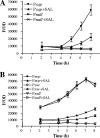Salicylic acid diminishes Staphylococcus aureus capsular polysaccharide type 5 expression
- PMID: 20008532
- PMCID: PMC2825945
- DOI: 10.1128/IAI.00245-09
Salicylic acid diminishes Staphylococcus aureus capsular polysaccharide type 5 expression
Abstract
Capsular polysaccharides (CP) of serotypes 5 (CP5) and 8 (CP8) are major Staphylococcus aureus virulence factors. Previous studies have shown that salicylic acid (SAL), the main aspirin metabolite, affects the expression of certain bacterial virulence factors. In the present study, we found that S. aureus strain Reynolds (CP5) cultured with SAL was internalized by MAC-T cells in larger numbers than strain Reynolds organisms not exposed to SAL. Furthermore, the internalization of the isogenic nonencapsulated Reynolds strain into MAC-T cells was not significantly affected by preexposure to SAL. Pretreatment of S. aureus strain Newman with SAL also enhanced internalization into MAC-T cells compared with that of untreated control strains. Using strain Newman organisms, we evaluated the activity of the major cap5 promoter, which was significantly decreased upon preexposure to SAL. Diminished transcription of mgrA and upregulation of the saeRS transcript, both global regulators of CP expression, were found in S. aureus cultured in the presence of SAL, as ascertained by real-time PCR analysis. In addition, CP5 production by S. aureus Newman was also decreased by treatment with SAL. Collectively, our data demonstrate that exposure of encapsulated S. aureus strains to low concentrations of SAL reduced CP production, thus unmasking surface adhesins and leading to an increased capacity of staphylococci to invade epithelial cells. The high capacity of internalization of the encapsulated S. aureus strains induced by SAL pretreatment may contribute to the persistence of bacteria in certain hosts.
Figures




Similar articles
-
Salicylic acid enhances Staphylococcus aureus extracellular adhesin protein expression.Microbes Infect. 2011 Nov;13(12-13):1073-80. doi: 10.1016/j.micinf.2011.06.003. Epub 2011 Jun 21. Microbes Infect. 2011. PMID: 21714946
-
Capsule-negative Staphylococcus aureus induces chronic experimental mastitis in mice.Infect Immun. 2005 Dec;73(12):7932-7. doi: 10.1128/IAI.73.12.7932-7937.2005. Infect Immun. 2005. PMID: 16299284 Free PMC article.
-
The Active Component of Aspirin, Salicylic Acid, Promotes Staphylococcus aureus Biofilm Formation in a PIA-dependent Manner.Front Microbiol. 2017 Jan 23;8:4. doi: 10.3389/fmicb.2017.00004. eCollection 2017. Front Microbiol. 2017. PMID: 28167931 Free PMC article.
-
Staphylococcus aureus capsular polysaccharides: a structural and synthetic perspective.Org Biomol Chem. 2020 Feb 7;18(5):783-798. doi: 10.1039/c9ob02546d. Epub 2020 Jan 10. Org Biomol Chem. 2020. PMID: 31922180 Review.
-
Staphylococcus aureus adaptation to the host and persistence: role of loss of capsular polysaccharide expression.Future Microbiol. 2010 Dec;5(12):1823-32. doi: 10.2217/fmb.10.147. Future Microbiol. 2010. PMID: 21155664 Review.
Cited by
-
Aspirin Effect on Staphylococcus aureus-Platelet Interactions During Infectious Endocarditis.Front Med (Lausanne). 2019 Oct 15;6:217. doi: 10.3389/fmed.2019.00217. eCollection 2019. Front Med (Lausanne). 2019. PMID: 31681776 Free PMC article. Review.
-
Neutrophil Functional Heterogeneity: Identification of Competitive Phagocytosis.Front Immunol. 2017 Nov 9;8:1498. doi: 10.3389/fimmu.2017.01498. eCollection 2017. Front Immunol. 2017. PMID: 29170663 Free PMC article.
-
Diflunisal and Analogue Pharmacophores Mediating Suppression of Virulence Phenotypes in Staphylococcus aureus.Antibiotics (Basel). 2023 Jul 12;12(7):1180. doi: 10.3390/antibiotics12071180. Antibiotics (Basel). 2023. PMID: 37508276 Free PMC article.
-
Editorial on low-dose acetylsalicylic acid treatment and impact on short-term mortality in Staphylococcus aureus bloodstream infection: a propensity score-matched cohort study.Ann Transl Med. 2016 May;4(10):199. doi: 10.21037/atm.2016.05.35. Ann Transl Med. 2016. PMID: 27294095 Free PMC article.
-
Sodium salicylate interferes with quorum-sensing-regulated virulence in chronic wound isolates of Pseudomonas aeruginosa in simulated wound fluid.J Med Microbiol. 2020 May;69(5):767-780. doi: 10.1099/jmm.0.001188. Epub 2020 Apr 22. J Med Microbiol. 2020. PMID: 32320374 Free PMC article.
References
-
- Adhikari, R. P., and R. P. Novick. 2008. Regulatory organization of the staphylococcal sae locus. Microbiology 154:949-959. - PubMed
-
- Alvarez, L. P., M. S. Barbagelata, A. L. Cheung, D. O. Sordelli, and F. R. Buzzola. 2008. Abstr. XII Int. Cong. Bacteriol. Appl. Microbiol., abstr. BP-17.
-
- Blickwede, M., R. Goethe, C. Wolz, P. Valentin-Weigand, and S. Schwarz. 2005. Molecular basis of florfenicol-induced increase in adherence of Staphylococcus aureus strain Newman. J. Antimicrob. Chemother. 56:315-323. - PubMed
-
- Buzzola, F. R., L. P. Alvarez, L. P. Tuchscherr, M. S. Barbagelata, S. M. Lattar, L. Calvinho, and D. O. Sordelli. 2007. Differential abilities of capsulated and noncapsulated Staphylococcus aureus isolates from diverse agr groups to invade mammary epithelial cells. Infect. Immun. 75:886-891. - PMC - PubMed
Publication types
MeSH terms
Substances
LinkOut - more resources
Full Text Sources
Molecular Biology Databases
Miscellaneous

